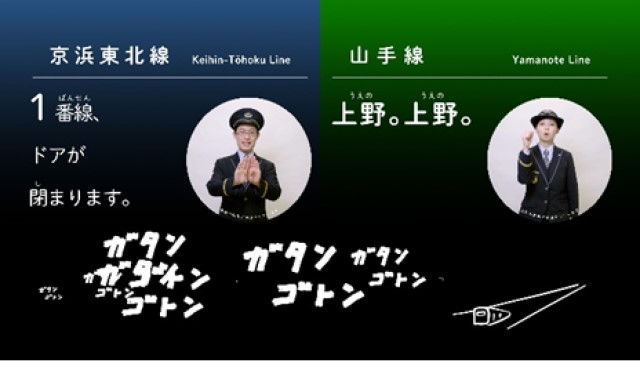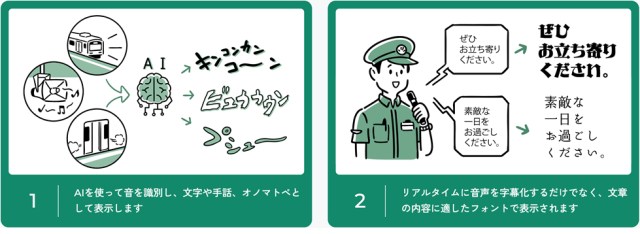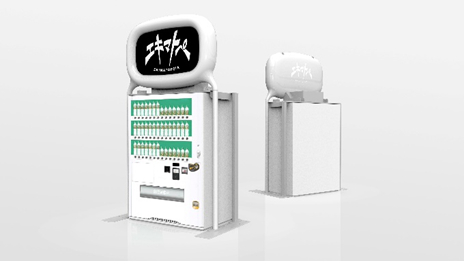Ueno Station has signs that show ambient sounds as onomatopoeia for deaf passengers

One of the most fun accessibility features you’ll ever see.
Train stations in Japan can be chaotic places full of rushing machinery, echoing chimes, and a steady stream of announcements. In no city is this more frequently true than the metropolis of Tokyo, where commuting can be especially daunting for the city’s many differently-abled people such as those in the deaf and hearing-impaired community.
And to make life a little easier for them IT giant Fujitsu has come up with Ekimatopeia.
▼ A news report about Ekimatopeia
Ekimatopeia consists of a large screen display posted on the train station’s boarding platform onto which manga-style onomatopoeic sounds are displayed. These sounds actually represent what an AI picks up through a microphone and interprets in real-time.
▼ A diagram of how Ekimatopeia works: It would be cool if it really were a giant brain with wires coming out of it, but that’s probably asking too much.

So, if a train were approaching the platform its clanking “gachan-gachan-gachan” sound would be splashed across the screen. If the train were slowing down to a stop, if an express was speeding through, or even if an alarm or horn sounded, it would all be visualized by words on the screen. Its rather detailed too, so that if a really nice train was gliding by, the screen would show a pleasing “hyuuuuuuuuu” and a slightly rougher one with a modified “byuuuuun.”
In addition, announcements by station staff are dictated on the screen and in the case of pre-recorded messages a sign language interpreter is also shown. The name “Ekimatopeia” comes from the Japanese word for station, “eki,” and a few syllables from the English word “onomatopoeia.”
▼ The eternal question: Is Ekimatopeia attached to a vending machine, or is a vending machine attached to Ekimatopeia?

Fujitsu got the idea from students at a school for deaf people who talked about how they felt when commuting to school by train. Some had said that they were scared because they don’t always notice the train as it approaches and that navigating the sometimes extremely complex stations would be easier with some guidance in sign language.
Project leader Tatsuya Honda said that when coming up with Ekimatopeia, they wanted to make something that not only addressed these problems but would also be fun for people with all types of hearing. “I’d be happy if people think about what kind of problems deaf people face,” said Honda, “and I’d be happy if we could become a kinder society.”
▼ A video on the creation of Ekimatopeia with English subtitles
I know I could just sit and gawk at Ekimatopeia for a long time, and it seems I’m not alone as online comments have shown near unanimous praise for it too.
“I want this to be actively adopted everywhere.”
“I love the style of fonts they use.”
“My daughter commutes to a school for the deaf and can’t know when delays occurs. She also can’t ask anyone because staff usually don’t know sing language, so this is very helpful.”
“That’s something we can be proud of having in Japan.”
“I want Ekimatope in all stations!”
“This is just the beginning to. It can get even better.”
“It’s like JoJo’s Bizarre Adventure.”
“The best part is that they made it fun. More technology needs to consider fun.”
At the moment, Ekimatopeia is only installed on the Keihin-Tohoku Line/Yamanote Line platform of JR Ueno Station in Tokyo, but Honda hopes that it becomes more widely adopted, perhaps even as a “Soramatopeia” version for use in airports. Considering its usefulness, popularity, and seemingly low-cost setup, it’s hard to imagine why this technology won’t spread throughout Japan, and maybe even beyond, in the future.
Source: Nikkei Shimbun, YouTube/日テレNEWS
Images: Fujitsu
● Want to hear about SoraNews24’s latest articles as soon as they’re published? Follow us on Facebook and Twitter!
Credit:

0 comments:
Post a Comment